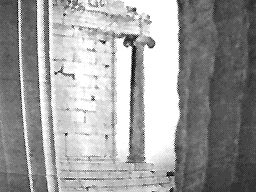








There are two issues that will be emphasized throughout this course that are crucial to the understanding of Architectonics:
the capability of a structural system to transmit various loadings safely to the ground.
Crawling on four points of support proves to be a very stabile situation for quite a long time. The "leap" to the unstable two point stance is the next development in our understanding of the influence of gravity. Again, the structural system must develop to the point that the individual elements of the system have acquired sufficient strength. The first steps are made: an action of supreme coordination of hundreds of elements that becomes second nature to homo sapiens.
The list can be extrapolated to touch on many aspects of the human experience; riding tricycles and bicycles, jumping on trampolines, exercising on parallel bars, sliding on ice skates, sailing in a heavy wind, rocking a small boat, . . . . the list is endless. These are part of the human experience and each and every one rely on an inherent understanding of strength and stability.
How many times has a parent scolded a child to "put four on the floor!!!"? What the parent really means to say is, "if you do not put all of the legs of your chair on the ground, you are going to tip over!" Both strength and stability issues are addressed in this simple exclamation. Under normal conditions, the elements which make up the chair (its legs, bracing and seat) can easily resist vertical loads. The strength of the individual elements of the chair has been designed to be sufficent for this type of static load. The seat (as a horizontal load-bearing element) must transfer its load through a connection to the legs (vertical load-bearing elements). Granted, some chairs will withstand a greater load than others, but they all resist the pull of gravity on the person sitting in them. If the legs cannot support the applied load they will fracture or break. These are examples of strength failure.

The stability of the system of elements depends upon the orientation of the chair in space. When it stands upright, on all four legs, it is a stable system. If it is on it's side, the chair might not be able to resist the loads for which it was designed. As it is tilted onto the back two legs, the structural system loses its equilibrium. At a certain point the chair as a system becomes unstable, fails and gravity pulls the supported load to the ground. This is a stability failure. In this type of failure, the individual elements retain their strength even as the system fails. The chair (system) could also have failed if the two supporting legs had experienced a strength failure (broken).
In each of these situations the chair, as a structural system, has reached the limit of its strength. As the saying goes, a chain (structural system) is only as strong as the weakest link (element)!
Any structural system can be studied in light of these two issues. For example, the column of the Greek temple shown above is an element that can experience a strength (crushing) failure, or a system (buckling) failure. It is/was part of a larger structural system.